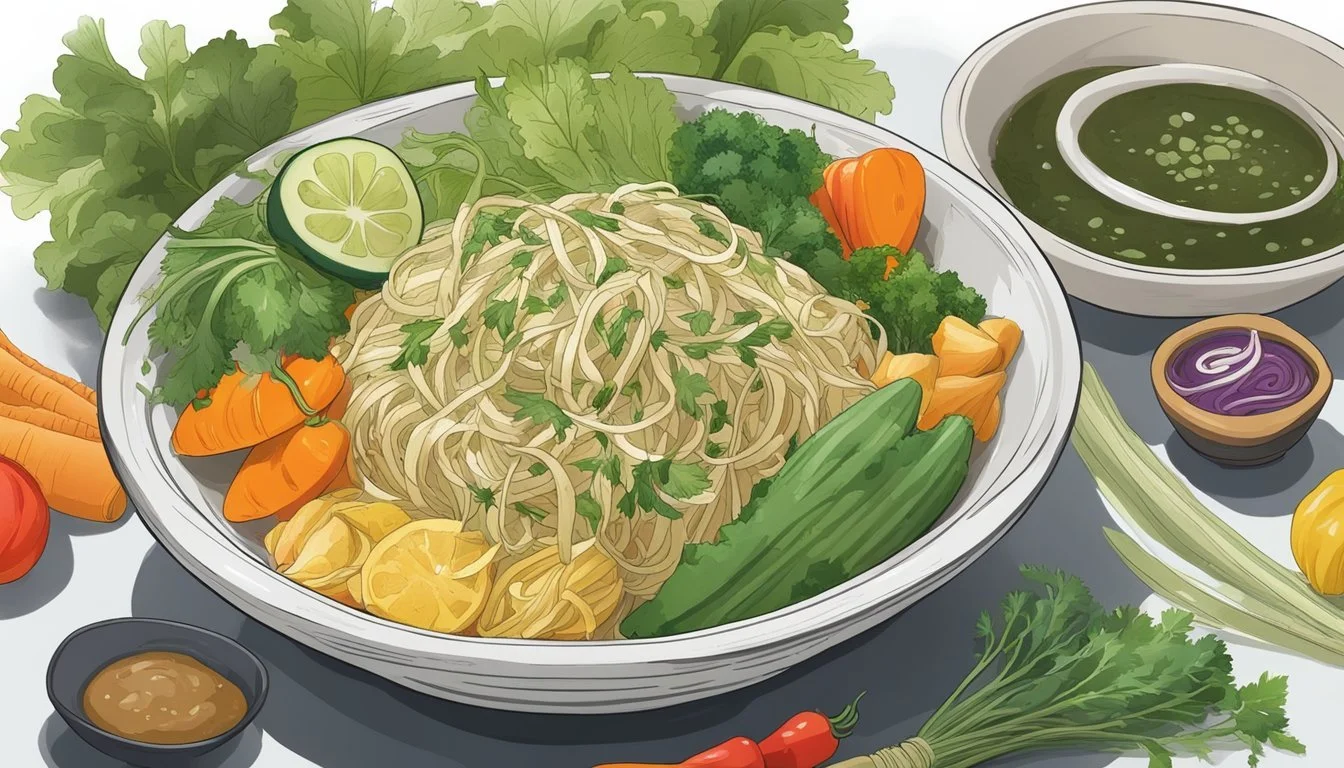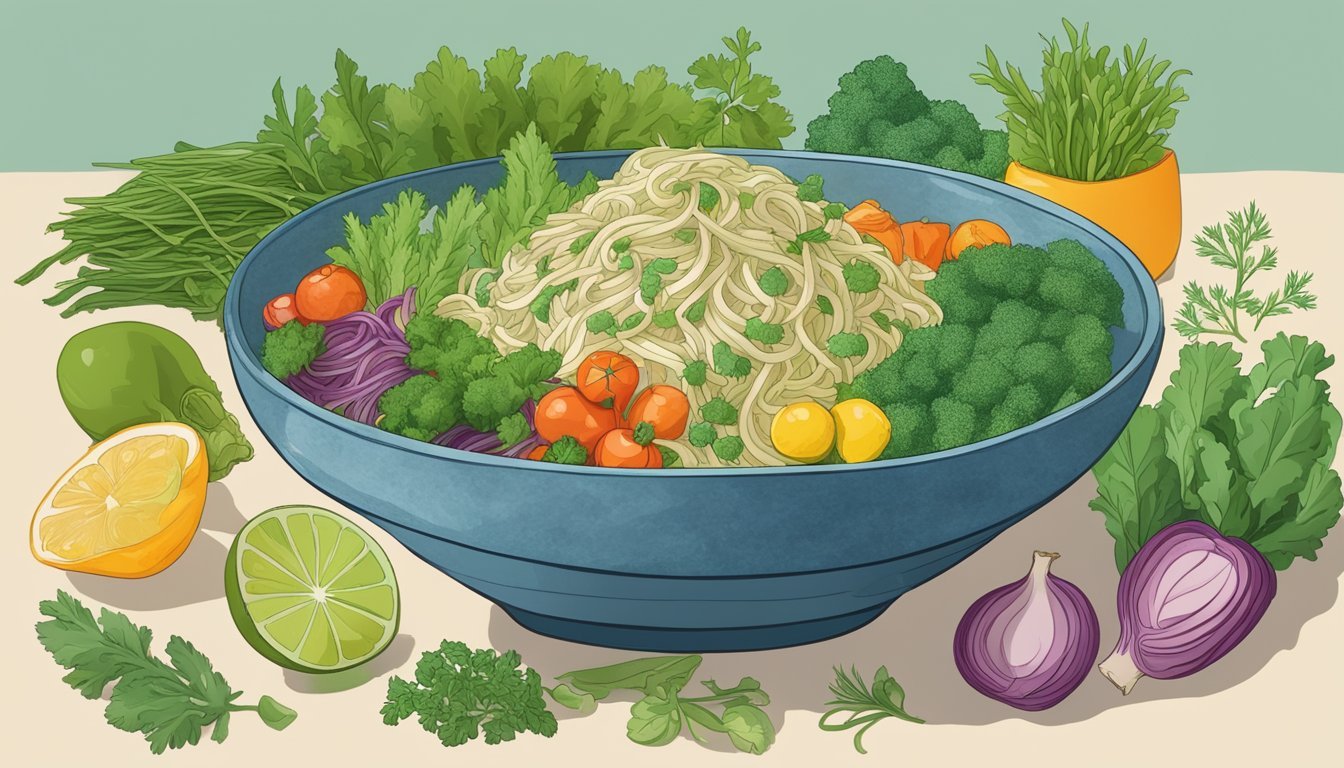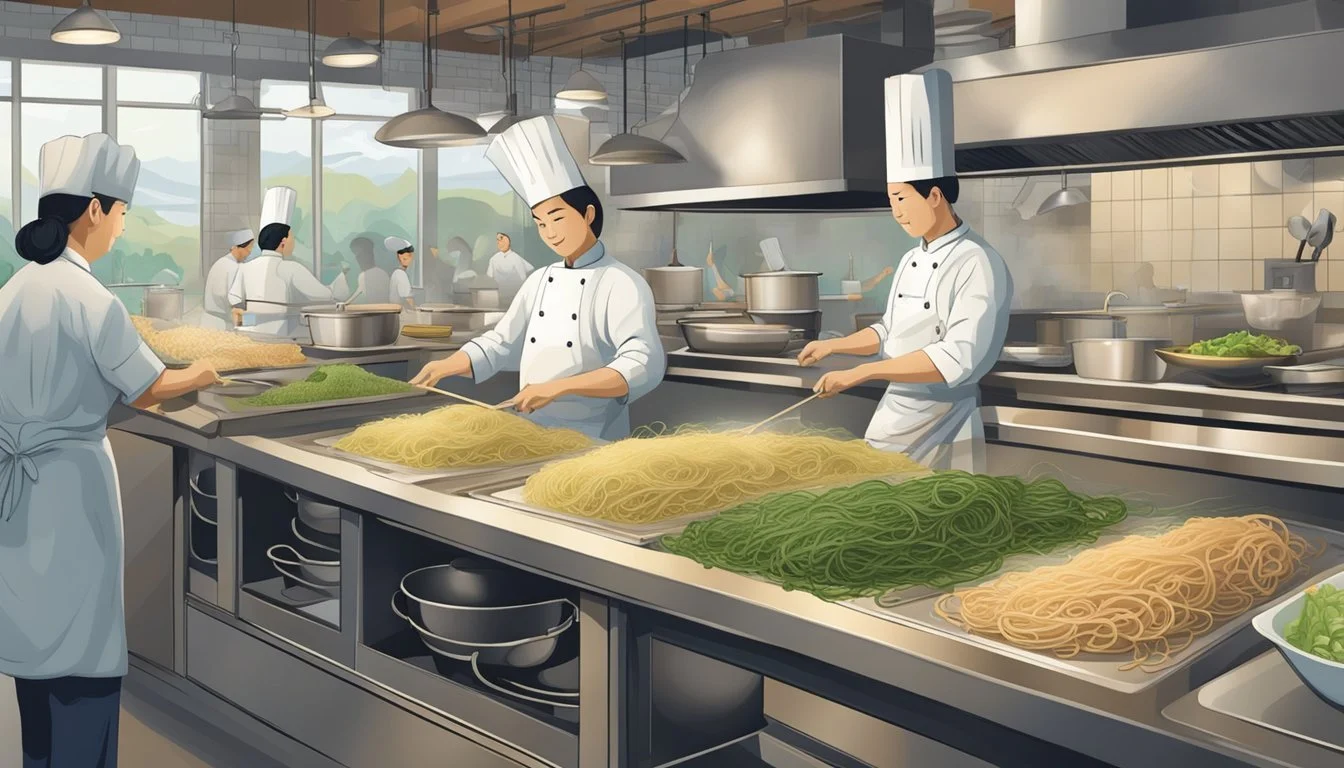Kelp Noodle Substitutes
Top Alternatives for Your Dishes
Kelp noodles are a nutritious alternative to traditional pasta that are gaining popularity among health-conscious individuals. Made from edible seaweed, these translucent and gelatinous noodles serve not only as a low-carb and gluten-free pasta (What wine goes well with pasta?) substitute, but also as an addition to a variety of dietary routines. Rich in minerals such as iodine and calcium, kelp noodles can add a unique texture and nutritional boost to meals. They are especially appealing to those following keto, paleo, or other low-carb diets, as they offer a means to enjoy pasta-like dishes without deviating from dietary restrictions.
Unlike traditional pasta that is high in gluten and carbohydrates, kelp noodles are free from gluten and contain only a minimal amount of carbs. This makes them a favorable option for individuals with gluten sensitivities or those aiming to reduce their carb intake. In addition to their advantageous macronutrient profile, kelp noodles supply the body with essential vitamins and fibers. Their versatility in the culinary world allows them to be incorporated into an array of recipes, from simple stir-fries to sophisticated salads.
As the interest in healthier eating continues to rise, the availability and variety of pasta alternatives expand, with kelp noodles being part of this growing trend. They are a testament to the innovation in food choices that cater to diverse nutritional needs and preferences while also opening up new avenues for culinary creativity. Whether one is looking to make a healthy swap or simply diversify their palate, kelp noodles present an avenue worth exploring.
Health Benefits of Kelp Noodles
Kelp noodles are celebrated for their low-calorie content and nutrient-rich profile, which can contribute positively to dietary goals and health.
Nutrient Composition
Kelp noodles are composed largely of water but provide a significant amount of essential minerals. They contain calcium, magnesium, and iodine, which are integral for bone health, muscle function, and thyroid regulation, respectively. As a bonus, they are naturally gluten-free, making them suitable for individuals with gluten sensitivities or celiac disease. These noodles are also low in carbohydrates; for example, a typical 100g serving may contain as little as 1.3g of carbohydrates.
Nutrition Table for Kelp Noodles (Per 100g Serving)
Nutrient Amount Carbohydrates 1.3g Dietary Fiber 0.2g Net Carbs 1.1g Minerals Varied
Weight Loss and Diet
The low-calorie and low-carb nature of kelp noodles makes them an attractive option for weight loss diets and meal planning. They are particularly compatible with a keto diet, where the goal is to stay within a daily net carb limit — usually between 20 to 50g. Their minimal caloric impact also helps maintain a calorie deficit, which is crucial for weight loss. Since they contain a modest amount of dietary fiber, kelp noodles can aid in digestion and provide a feeling of fullness, which may reduce overall calorie intake.
Understanding Pasta Alternatives
Choosing pasta alternatives can be driven by dietary restrictions, health goals, or a desire for variety in one's diet. It is important to understand the nutritional profile and culinary uses of each alternative to make an informed choice.
Gluten-Free Options
Gluten-free options have become a staple for those with gluten sensitivities or celiac disease. Kelp noodles, made from brown seaweed, stand out as a gluten-free alternative to traditional pasta. They offer a unique texture that is crunchy and can be softened with lemon juice or by cooking. Another popular choice is brown rice pasta, which offers a texture and flavor more akin to that of traditional wheat noodles.
Kelp Noodles: Almost zero carbohydrates and rich in minerals.
Brown Rice Pasta: Higher in carbohydrates but still gluten-free and with a familiar taste.
Low Carb and Keto-Friendly Choices
For individuals following a low-carb diet or striving for ketosis, pasta alternatives that minimize carbohydrate intake are essential. Keto pasta and low carb pasta options include shirataki noodles, which are made from the konjac yam and contain very few digestible carbs. There are edamame noodles made from young soybeans, which are not only low in carbohydrates but also high in protein.
Low-Carb Alternatives Table
Alternative Carb Content Notes Kelp Noodles Very low Help maintain ketosis, nutrient-rich Shirataki Noodles Very low Can mimic traditional noodles' texture, almost zero calorie Edamame Pasta Moderate Higher protein, suitable for a balanced low-carb diet
Consumers should always check labels to ensure the fit with their dietary goals, as carb content can vary widely between brands and types of low-carb pastas.
Popular Kelp Noodle Substitutes
Kelp noodles are valued for their health benefits and distinct crunchy texture, but several alternatives offer similar nutritional profiles and are equally versatile in recipes.
Vegetable-Based Noodles
Vegetable-based noodles are ideal for those following a low-carb, paleo, or vegan diet, providing a similar texture to kelp noodles with a boost of nutrients. Zucchini noodles, also known as "zoodles," are a popular choice made using a spiralizer to create strands that mimic the size and shape of traditional pasta. Spaghetti squash is another alternative, easily forked into spaghetti-like strands after cooking. Other vegetables like cucumbers, carrots, and sweet potatoes can also be transformed into noodle form, offering a variety of flavors and textures.
Grain and Legume Noodles
For those who prefer a more pasta-like taste, grain and legume noodles are excellent substitutes. Rice noodles are widely used in Asian cuisines and come in various thicknesses suitable for dishes like pho and pad Thai. Soba noodles, made from buckwheat flour, provide a nutty flavor and are typically used in Japanese dishes. Legume-based options, such as black bean pasta and bean pasta, are known for their higher protein content making them suitable for fitness enthusiasts.
Alternative Low-Carb Noodles
Nutrition-conscious individuals may opt for low-carb noodles as an alternative to kelp noodles. Shirataki noodles, made from the konjac yam, are virtually carb-free and calorie-free, fitting into a keto-friendly diet seamlessly. Konjac noodles, also made from the same plant, are similar in texture to kelp noodles and absorb the flavors of the dish they are in. Egg noodles, while not as low in carbohydrates, offer a higher protein content and a familiar chewy texture to those seeking a more traditional noodle experience without the high carb count.
Cooking and Preparation Tips
When cooking with kelp noodles, one should focus on appropriate cooking methods and flavor pairings to enhance their unique texture and ensure that sauces adhere well to the noodles.
Cooking Methods
Kelp noodles benefit from simple cooking techniques to achieve the optimal texture, similar to traditional pasta. Before cooking, they should be rinsed thoroughly under tap water. To soften the noodles, one can use a mixture of lemon juice and baking soda, massaging the noodles for about a minute to transform the texture from crunchy to tender.
Boil: Placing kelp noodles in boiling water for 5-10 minutes is a favored method. It's crucial not to overcook as they may become mushy.
Rinse: After boiling, they should be drained and rinsed under cold water to halt the cooking process and prevent clumping.
Massage: For a more al dente texture, massaging the noodles with lemon juice and baking soda prior to cooking can make them pliable.
Flavor Pairing
Kelp noodles possess a neutral flavor profile, making them an excellent canvas for an array of sauces and ingredients. The absence of a strong taste means they absorb the nuanced flavors of accompanying components effectively.
Marinara Sauce: The slight acidity of tomato-based marinara sauce complements the mild nature of kelp noodles well, and their texture allows for good sauce adherence.
Alfredo Sauce: Creamy alfredo sauce can provide a rich, decadent flavor and the noodles will remain distinct within the creamy texture.
Fork-Ready Dishes: Kelp noodles should be served in a way that allows for easy twirling on a fork, akin to traditional pasta, to enhance the eating experience.
In both cooking methods and flavor pairing, one should strive for a balance that respects the singular qualities of kelp noodles while providing a satisfying and inviting dish.
Recipes and Usage Ideas
Kelp noodles are a versatile ingredient often used as a substitute for traditional pasta. They can be seamlessly incorporated into a variety of dishes, offering a gluten-free and low-carb option for those looking to maintain certain dietary patterns. Here are some alternatives and how one might use them in recipes:
Zoodles (Zucchini Noodles): Replace kelp noodles with zoodles in stir-fries or salads. They provide a similar texture and are perfect for soaking up sauces.
Spiralized Carrots: Add a sweet crunch to wraps or spring rolls in place of kelp noodles.
Vegetable-based Noodles:
Cauliflower Rice: Use as a substitute in kelp noodle-based dishes that are stir-fried or mixed with sauce.
Eggplant Noodles: They can be layered in casseroles for a hearty, nutritious dish.
Kohlrabi Noodles: Great for slaws or salads, adding a mild, sweet flavor.
Other Substitutes:
Cabbage Noodles: These work well in soups and broths as a substitute for kelp noodles.
Ramen Noodle Substitutes: For a similar soup base, consider shirataki noodles or spiralized veggies.
Here are some specific usage ideas laid out in a simple format:
Substitute Recommended Usage Zoodles Pesto dishes, marinara-based sauces Spiralized Carrot Asian salads, cold noodle dishes Cauliflower Rice Stir-fry bases, grain-free rice dishes Eggplant Noodles Parmesan, lasagna alternatives Kohlrabi Noodles Coleslaws, light vinaigrette salads Cabbage Noodles Hearty stews, clear soups Shirataki Noodles Miso soups, ramen alternatives
Each alternative presents its own unique set of textures and flavors, and can be chosen based on the specific requirements of the dish being prepared. Whether one is following a keto, paleo, or gluten-free diet, these substitutes offer a world of culinary possibilities.
Dietary Considerations in Choosing Substitutes
When seeking alternatives to kelp noodles, individuals need to consider their unique dietary needs, particularly with regard to allergies, sensitivities, and macronutrient content, to make informed choices that align with their health goals.
Allergies and Sensitivities
Gluten Sensitivity: Individuals with celiac disease or gluten sensitivity should opt for substitutes that are certified gluten-free. While kelp noodles are naturally gluten-free, other pasta alternatives like rice noodles and certain brands of pre-packaged gluten-free pastas are suitable options.
Common allergens to consider:
Soy: Some low-carb pasta substitutes, such as those made from edamame, contain soy, which is a common allergen.
Eggs: Egg noodles are a potential substitute but are unsuitable for anyone with egg allergies.
Important note: Always check the packaging for potential cross-contamination warnings if allergens are a concern.
Caloric and Carbohydrate Content
For individuals following a keto diet or any low-carb diet, the carbohydrate content is a crucial factor in choosing pasta alternatives.
Shirataki noodles: Made from glucomannan, these are an excellent low-carb option with minimal calories, aligning well with keto dietary requirements.
Low-carb pasta substitutes: Alternatives like zucchini noodles (zoodles) are high in fiber and low in calories and carbs, making them keto-friendly.
Table of Low-Carb Pasta Substitutes:
Substitute Carbohydrate Content Keto-Friendly Shirataki noodles <1g per serving Yes Zucchini noodles ~3g per cup Yes Edamame pasta Varies Often Yes
In selecting pasta alternatives, individuals must balance taste, texture preferences, and dietary considerations. Those with allergies or sensitivities should ensure the substitute is free from offending allergens, while those on keto or low-carb diets should prioritize substitutes with lower carbohydrate content.
Environmental and Economic Impacts
The trend toward consuming noodle substitutes like kelp noodles stems from environmental and economic considerations. Consumers and producers alike weigh the benefits and costs of alternative noodles against traditional options.
Sustainability of Alternative Noodles
Kelp noodles are celebrated for their lower environmental footprint compared to traditional farming methods for wheat or rice-based noodles. This factor is a significant draw for environmentally conscious consumers. Kelp farming doesn't require fertilizers, pesticides, or freshwater, reducing pollution and conserving resources. Moreover, kelp's capacity to absorb carbon dioxide and improve marine biodiversity further cements its sustainability credentials.
Konjac yam, another novel ingredient for noodle substitutes famously used in shirataki noodles, has a negligible environmental impact, requiring less water and land than traditional cereal crops.
Spiralized vegetable noodles, like those made from zucchini or carrots, although not as nutrient-dense, offer another sustainable option as they repurpose whole vegetables without extensive processing.
Cost Comparison
When it comes to economic considerations, the costs of alternative noodles like kelp may vary. Initial setup costs for kelp cultivation can be high, but ongoing maintenance and production costs are often lower than those associated with traditional agriculture. The economic viability depends on scales of production and market demand.
Noodle Type Production Cost Retail Price Kelp Noodles Low to moderate Moderate Glass Noodles Moderate Moderate Konjac Noodles Moderate to high Moderate to high
The price points of kelp noodles and other alternatives often reflect the scale of production and the target market segment. These alternatives may be more expensive than traditional pasta on the shelf, but prices can be expected to decrease as demand grows and production methods become more efficient.




